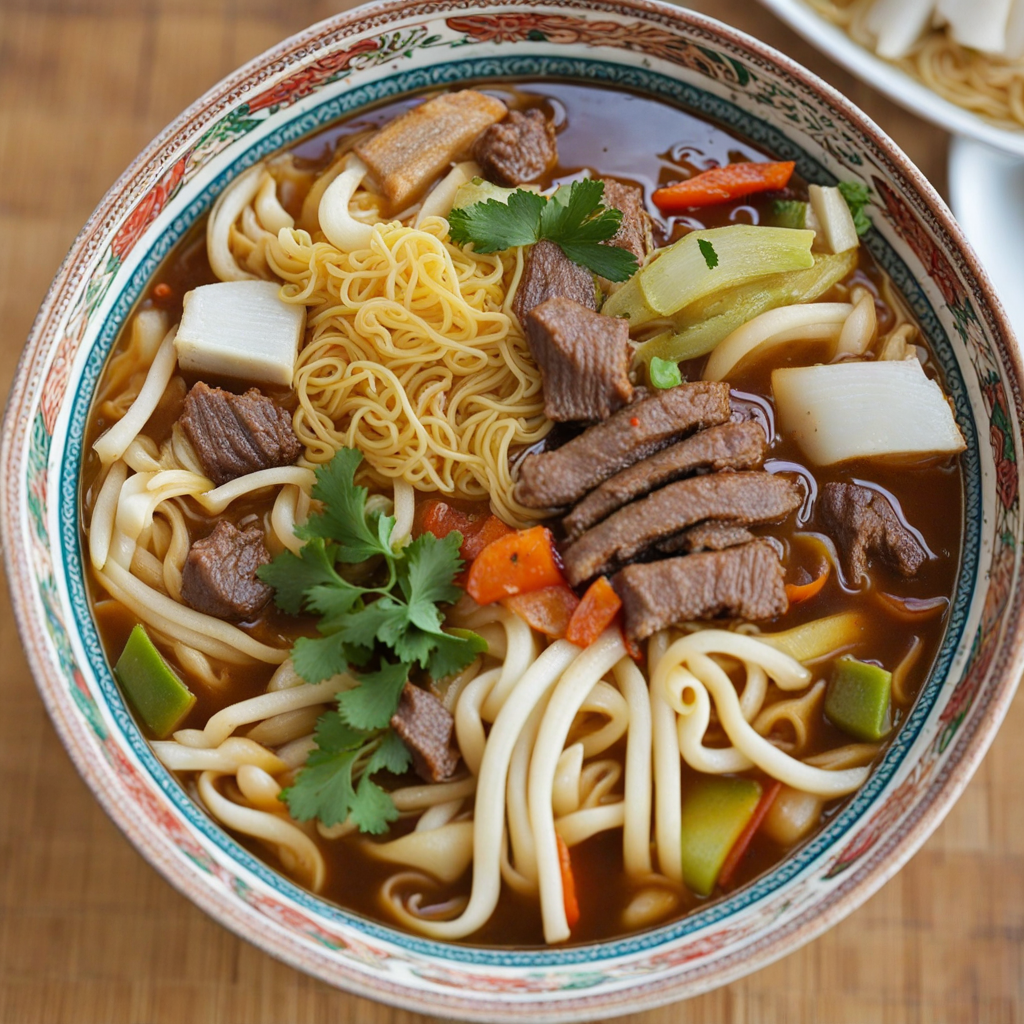Hasip
Hasip is a traditional Uzbek dish that exudes comfort and warmth, often enjoyed during family gatherings or festive occasions. It is a hearty soup made primarily from a rich meat broth, typically using lamb or beef, which is simmered for several hours to extract deep flavors. The broth is infused with a blend of aromatic spices, including cumin, coriander, and black pepper, which create a fragrant base that tantalizes the senses. The addition of vegetables such as carrots, onions, and potatoes enhances the dish's depth, adding both sweetness and earthiness to each spoonful. The defining feature of Hasip is its unique texture, achieved through the inclusion of rice or bulgur, which absorbs the savory broth and plumps up beautifully. As the grains cook, they become tender and slightly chewy, providing a delightful contrast to the succulent pieces of meat. Some variations of Hasip may also incorporate legumes like chickpeas for added protein and a nutty flavor, while fresh herbs like cilantro or parsley sprinkled on top provide a vibrant finish that brightens the dish. What truly sets Hasip apart is its communal nature; it is often served in large bowls for sharing, encouraging diners to gather around and savor this warm, nourishing meal together. The experience of enjoying Hasip goes beyond just tasting; it's about the connections formed over shared food, the stories exchanged, and the comfort found in each hearty bite. This dish is a perfect representation of Uzbek hospitality, showcasing the country's rich culinary heritage and the importance of food in bringing people together.
How It Became This Dish
The History of Хасип: A Culinary Gem from Uzbekistan #### Origins and Early History Хасип (Khasip) is a traditional dish that has deep roots in the rich culinary heritage of Uzbekistan, a country located at the crossroads of Central Asia. Uzbekistan's history as a major trading hub along the Silk Road played a significant role in the development of its cuisine, enabling the blending of various culinary traditions and ingredients. Хасип is believed to have originated in the ancient agricultural communities of the region, where rice and meat were staple foods. The dish is primarily composed of rice, meat (usually lamb or beef), onions, and a variety of spices. The foundation of Хасип lies in the nomadic lifestyle of the Uzbek people, who relied heavily on livestock for sustenance. As the nomads settled into more permanent agricultural practices, the introduction of rice cultivation in the fertile valleys of Uzbekistan led to the evolution of Хасип into a beloved dish. #### Cultural Significance Хасип is not just a meal; it is a dish steeped in cultural significance. Traditionally prepared for special occasions and communal gatherings, it embodies the spirit of hospitality that is so essential to Uzbek culture. Sharing food is a way of expressing love and friendship, and Хасип often takes center stage during family celebrations, weddings, and religious holidays. The preparation of Хасип is a communal activity, often involving family members or friends working together, which reinforces social bonds. The gathering around the cooking pot signifies unity and togetherness, with each person contributing to the creation of the dish. This communal aspect reflects the broader Uzbek philosophy of hospitality, where guests are treated with the utmost respect and generosity. In addition to its role in social gatherings, Хасип also has a symbolic connection to local traditions. For example, during the Navruz festival, which celebrates the Persian New Year and the arrival of spring, Хасип is often prepared to mark the occasion. It serves as a reminder of renewal, abundance, and the importance of community. #### Development Over Time As Uzbekistan transitioned through various historical periods—from the era of the Timurids to the Soviet Union—it experienced significant changes that influenced its culinary landscape. The incorporation of new ingredients and cooking techniques enriched the preparation of Хасип. For instance, during the Soviet era, the availability of various grains and processed foods led to adaptations of traditional recipes. However, despite these changes, the core elements of Хасип remained intact. In contemporary Uzbekistan, Хасип has gained recognition beyond its traditional roots and is now celebrated in restaurants and food festivals. Chefs are experimenting with the dish, introducing modern twists while still honoring its traditional roots. For instance, the use of different types of meat, such as chicken or even vegetarian versions with mushrooms and vegetables, has expanded its appeal to a wider audience. Moreover, the rise of global culinary trends has prompted chefs to incorporate international flavors, showcasing the versatility of Хасип. While the dish has evolved, its essence remains. Many families still cling to the traditional way of preparing Хасип, often passed down through generations, ensuring that the cultural significance and history are preserved. The ritual of cooking Хасип continues to be an opportunity for storytelling, where elders share tales of the past, enriching the experience around the table. #### Ingredients and Preparation The preparation of Хасип is both an art and a science. The key ingredients—rice, meat, and spices—are carefully selected to create a harmonious balance of flavors. The choice of rice is crucial; long-grain rice varieties, such as basmati or locally grown rice, are preferred for their ability to absorb flavors and maintain texture. The cooking process usually begins with sautéing onions in oil until they are golden brown, a technique that forms the flavor base of the dish. Meat is then added and browned, followed by the introduction of spices such as cumin, coriander, and black pepper. The rice is added next, along with water or broth, and the dish is left to simmer until the rice is cooked and has absorbed the rich flavors of the meat and spices. Traditionally, Хасип is served in a large communal dish, where diners can serve themselves, reinforcing the communal aspect of the meal. The presentation is often colorful, with garnishes of fresh herbs like dill or cilantro, adding visual appeal and freshness to the dish. #### Modern-Day Relevance Today, Хасип is more than just a dish; it is a symbol of Uzbekistan's cultural identity. As globalization continues to influence food culture, traditional dishes like Хасип are being celebrated for their unique flavors and historical significance. Culinary tourism has also played a role in this revival; visitors to Uzbekistan are increasingly interested in authentic dishes, and Хасип frequently appears on menus at restaurants eager to showcase the country's culinary heritage. The dish's adaptability also allows it to fit various dietary preferences, making it relevant in contemporary cuisine. With the rising interest in plant-based diets, chefs are creating versions that cater to vegetarians while still honoring the essence of Хасип. Furthermore, the rise of social media has enabled food enthusiasts to share their experiences with Хасип, fostering a global appreciation for this traditional dish. Pictures of beautifully plated Хасип, along with stories of its preparation, are shared widely, helping to immortalize the dish in the digital age. #### Conclusion Хасип is a dish that encapsulates the rich history, cultural significance, and evolving nature of Uzbek cuisine. From its origins among nomadic tribes to its role in contemporary dining, Хасип continues to be a beloved dish that brings people together. Its preparation signifies hospitality, community, and tradition, making it an integral part of Uzbekistan's culinary identity. As it adapts to modern tastes while retaining its roots, Хасип serves as a reminder of the importance of food in storytelling, culture, and connection.
You may like
Discover local flavors from Uzbekistan







